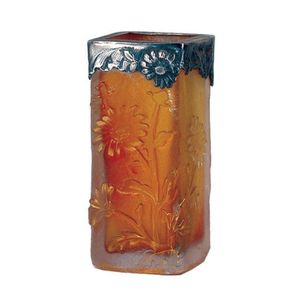Art Deco Gustavsberg Vase with Turquoise and Silver Overlay
You must be a subscriber, and be logged in to view price and dealer details.
Subscribe Now to view actual auction price for this item
When you subscribe, you have the option of setting the currency in which to display prices to $Au, $US, $NZ or Stg.
- Art Deco Period - The Art Deco period was a cultural movement that emerged in the 1920s and 1930s, and was characterized by its emphasis on modernism, luxury, and elegance. The name "Art Deco" comes from the Exposition Internationale des Arts Décoratifs et Industriels Modernes, a large exhibition held in Paris in 1925 that showcased the latest trends in decorative arts.
Art Deco was a reaction against the ornate and elaborate styles of the previous era, and reflected a new modern sensibility. It was characterized by streamlined, geometric shapes, bright colours, and the use of new materials such as chrome, glass, and Bakelite. Art Deco designers sought to create a sense of luxury and sophistication, often incorporating expensive materials such as ivory, marble, and rare woods.
Art Deco had a significant impact on a wide range of artistic fields, including architecture, fashion, graphic design, and interior design. Some of the most iconic examples of Art Deco architecture include the Empire State Building in New York City, the Hoover Building in London, and the Palais de Chaillot in Paris.
The Art Deco period came to an end in the 1940s, as World War II and changing cultural trends led to a shift in artistic styles. However, Art Deco remains an important influence on design and art, and continues to be celebrated for its modernist sensibility and glamorous aesthetic. - Royal Doulton "hn" Numbering System - The Royal Doulton "HN" numbering system has proven to be a very orderly way of identifying each individual Royal Doulton figure. The "HN" refers to Harry Nixon who was in charge of the new figure painting department in Doulton's very early years.
The HN numbering system has endured the test of time to be still used today. Over time, Royal Doulton has issued over 4000 individual HN numbers although they all are not new models - some are assigned to specific colourway variations and some cross over to be used to identify animal figures. - Circa - A Latin term meaning 'about', often used in the antique trade to give an approximate date for the piece, usually considered to be five years on either side of the circa year. Thus, circa 1900 means the piece was made about 1900, probably between 1895 and 1905. The expression is sometimes abbreviated to c.1900.
This item has been included into following indexes:
Visually similar items

Garry Nash, Untitled, ink and blown glass, signed and dated '89, 76 cm, 32 cm, 24 cm

Wedgwood Victorian jardieniere with faux lion head handles and grape vine bunting surrounded by maidens. Height 16 cm

A French Daum acid-etched and gilt cabinet vase, of square section decorated in high relief with sprays of chrysanthemums highlighted with gilding, the rim with a French hallmarked silver collar, red enamel factory mark under the base. Height 12 cm.

A Royal Doulton 'Souter's Cats' series ware miniature vase, cylindrical shape with small loop handles at the shoulder, decorated with three cat caricatures and the abbreviated motto ' Be Content, The Sea (Hath) Fish Enough'. Printed mark. Height 10.3 cm
